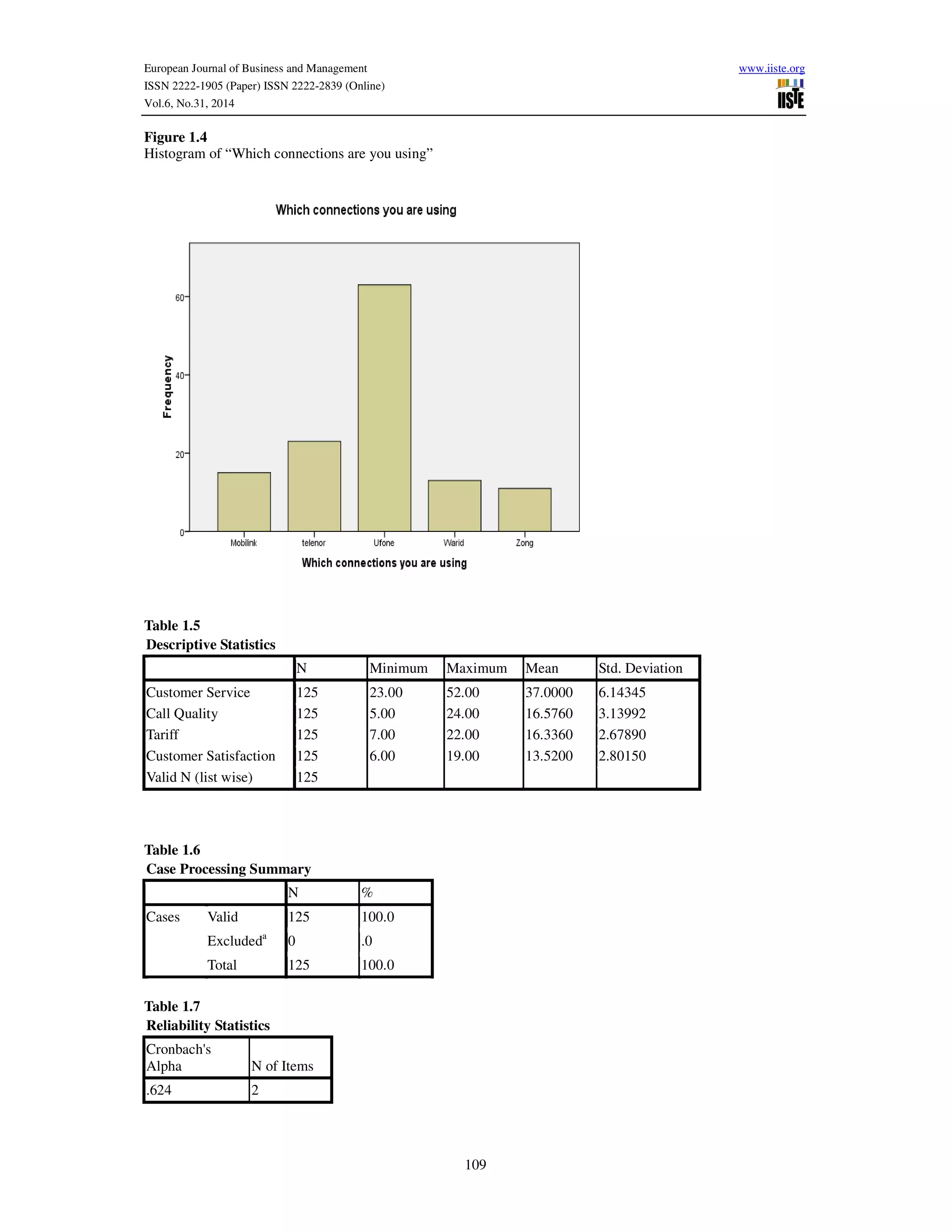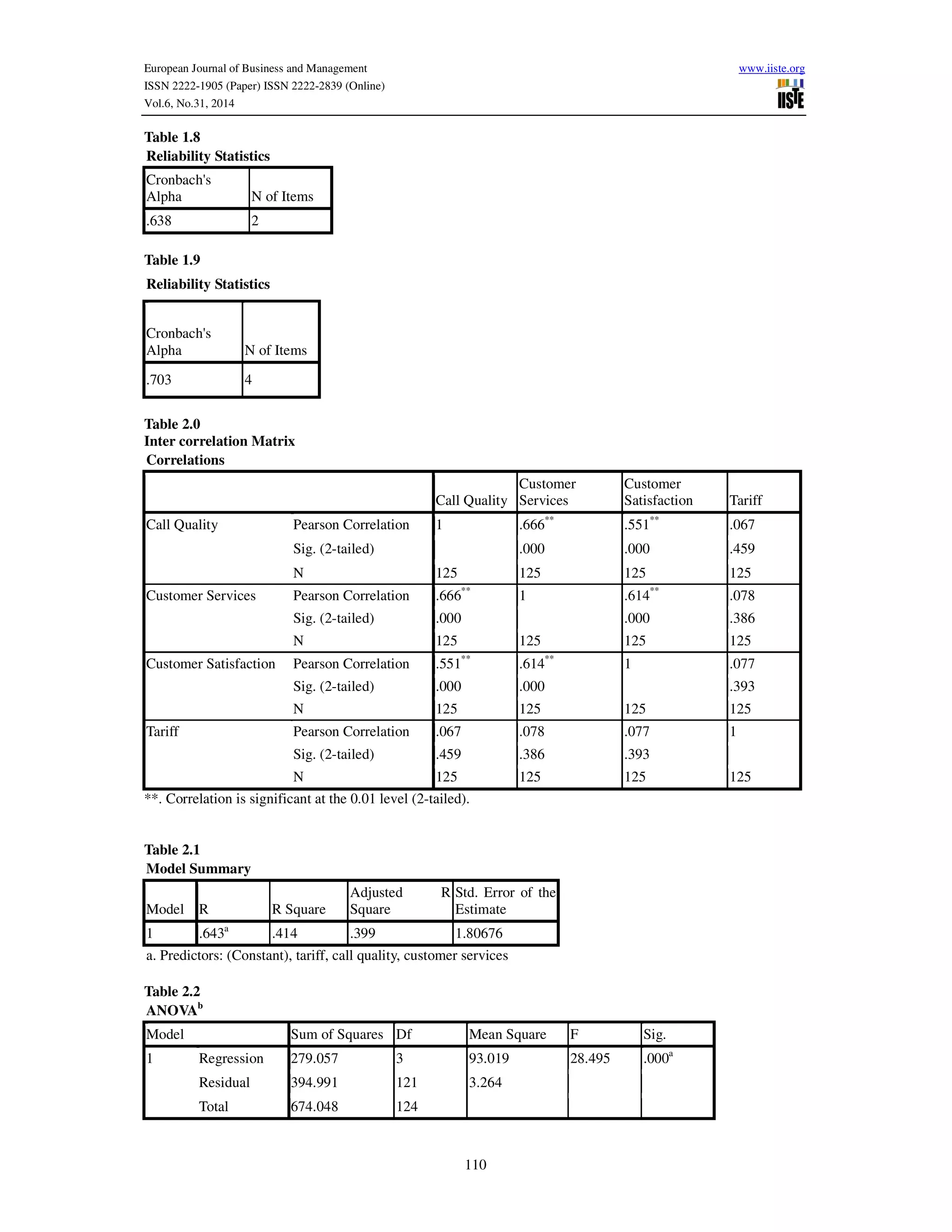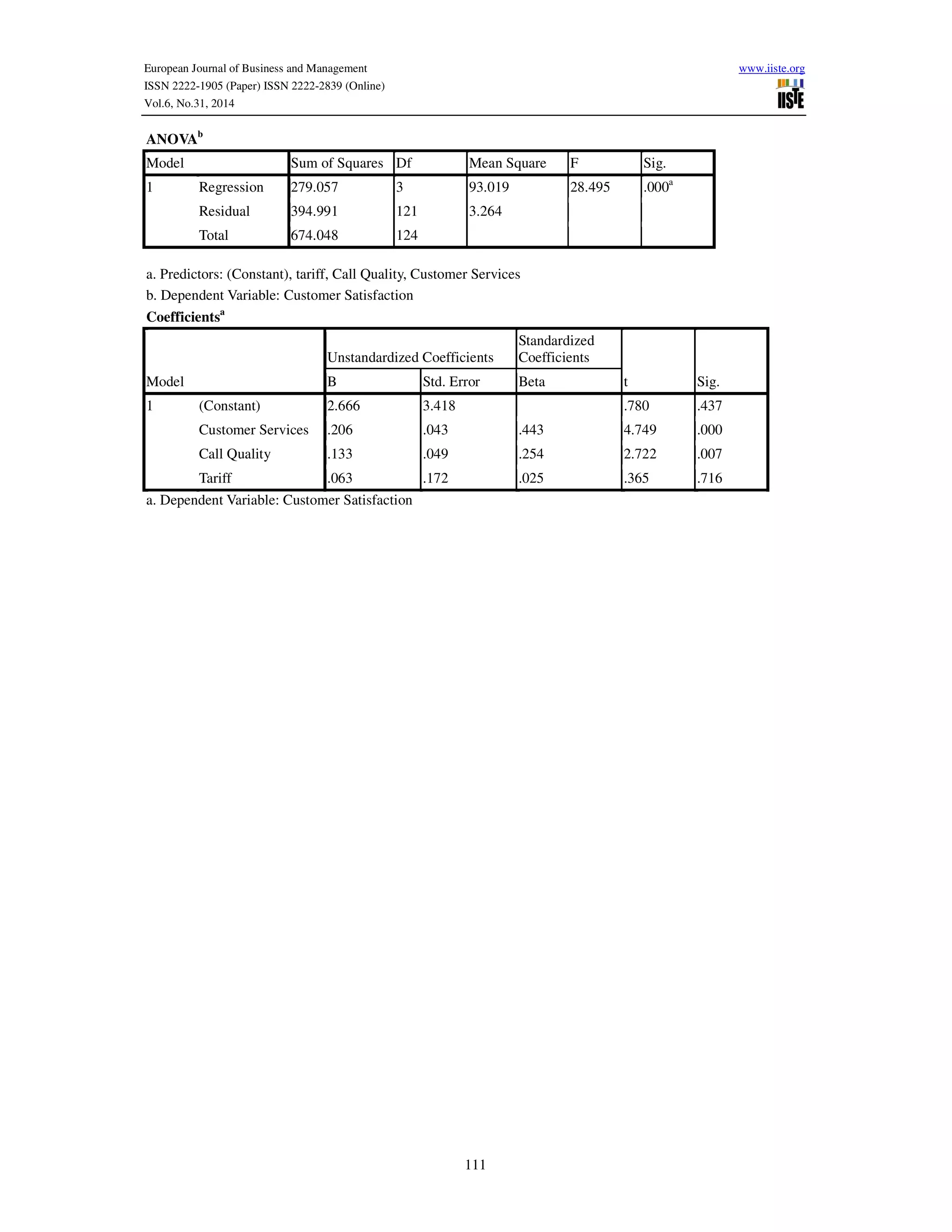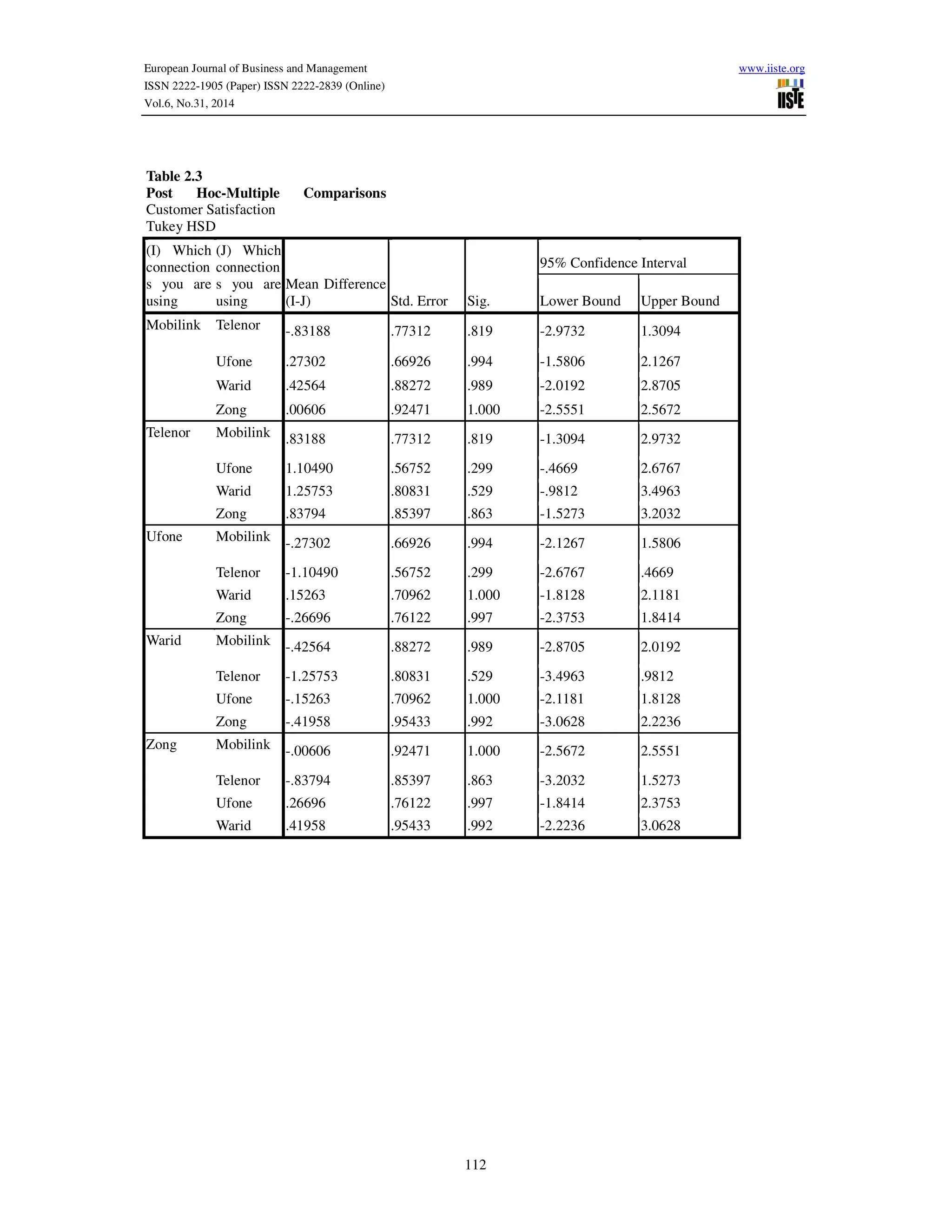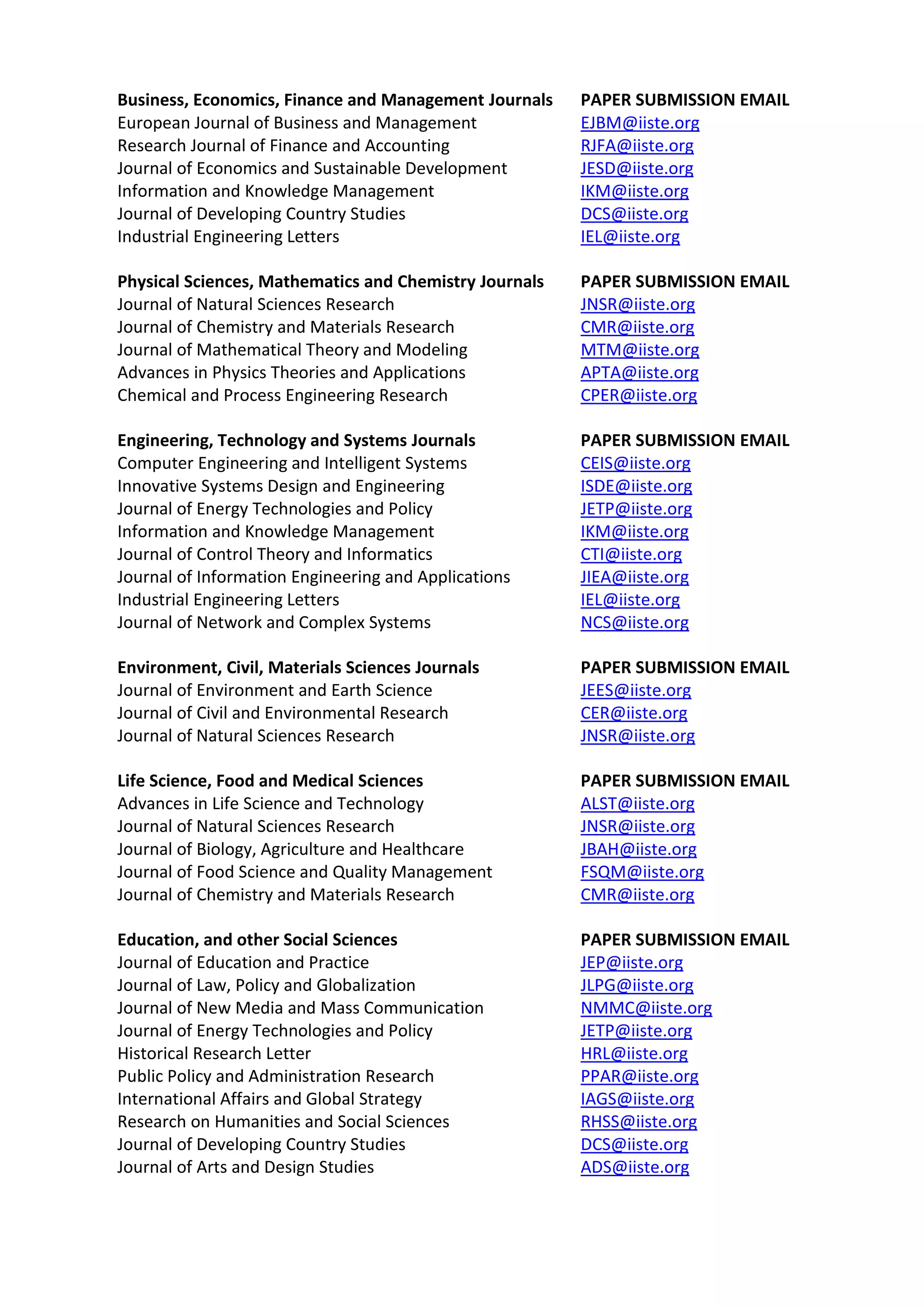This document summarizes a research study on the determinants of customer satisfaction in Pakistan's cellular industry. Through a literature review and survey, the study identified three key factors that influence customer satisfaction: (1) tariff (pricing), (2) call quality, and (3) customer service. The research found customer satisfaction in the cellular industry to be multidimensional, depending on an appropriate balance of affordable rates, high-quality network coverage and calls, and good customer support services. This adds to previous research identifying similar factors as important drivers of satisfaction in other countries' telecommunications markets.
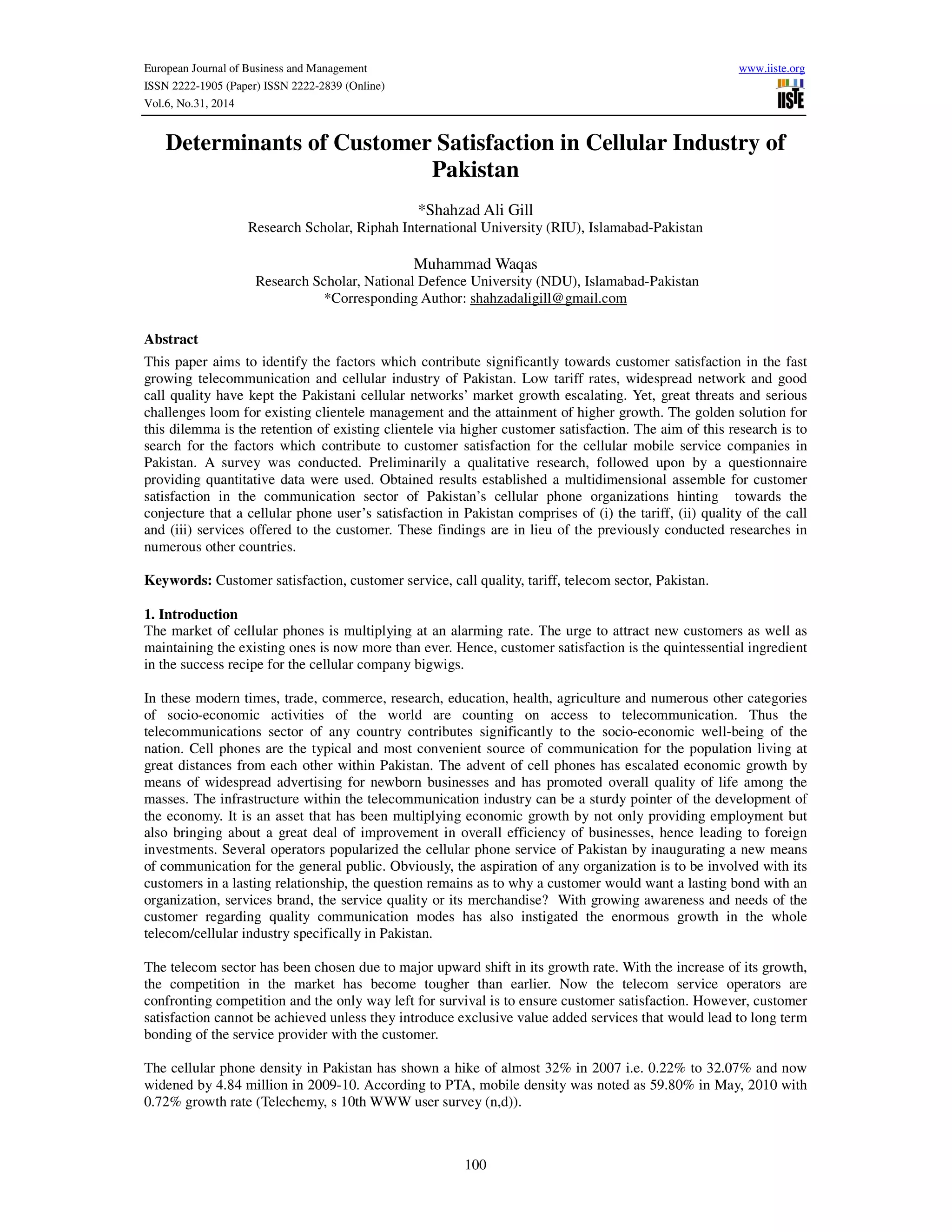
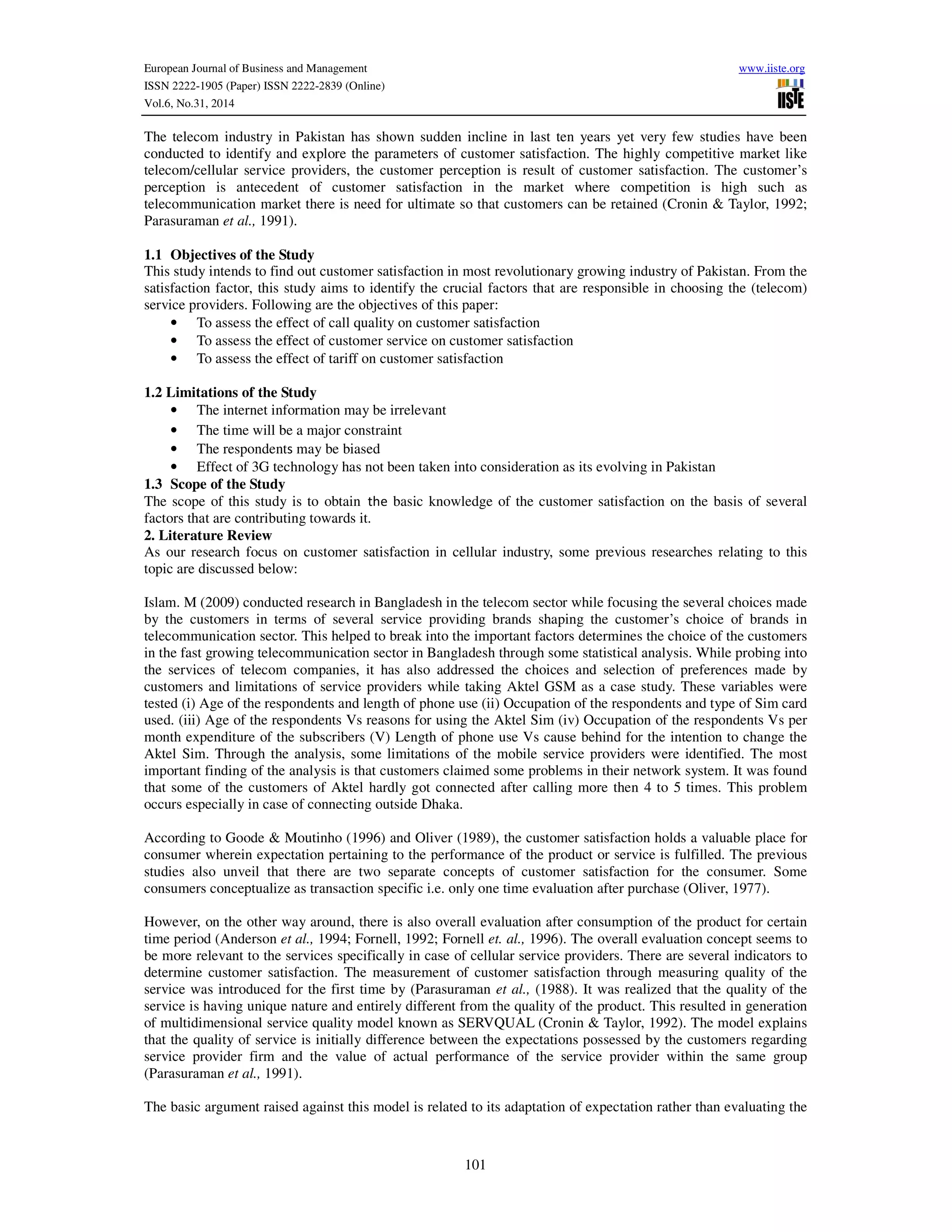
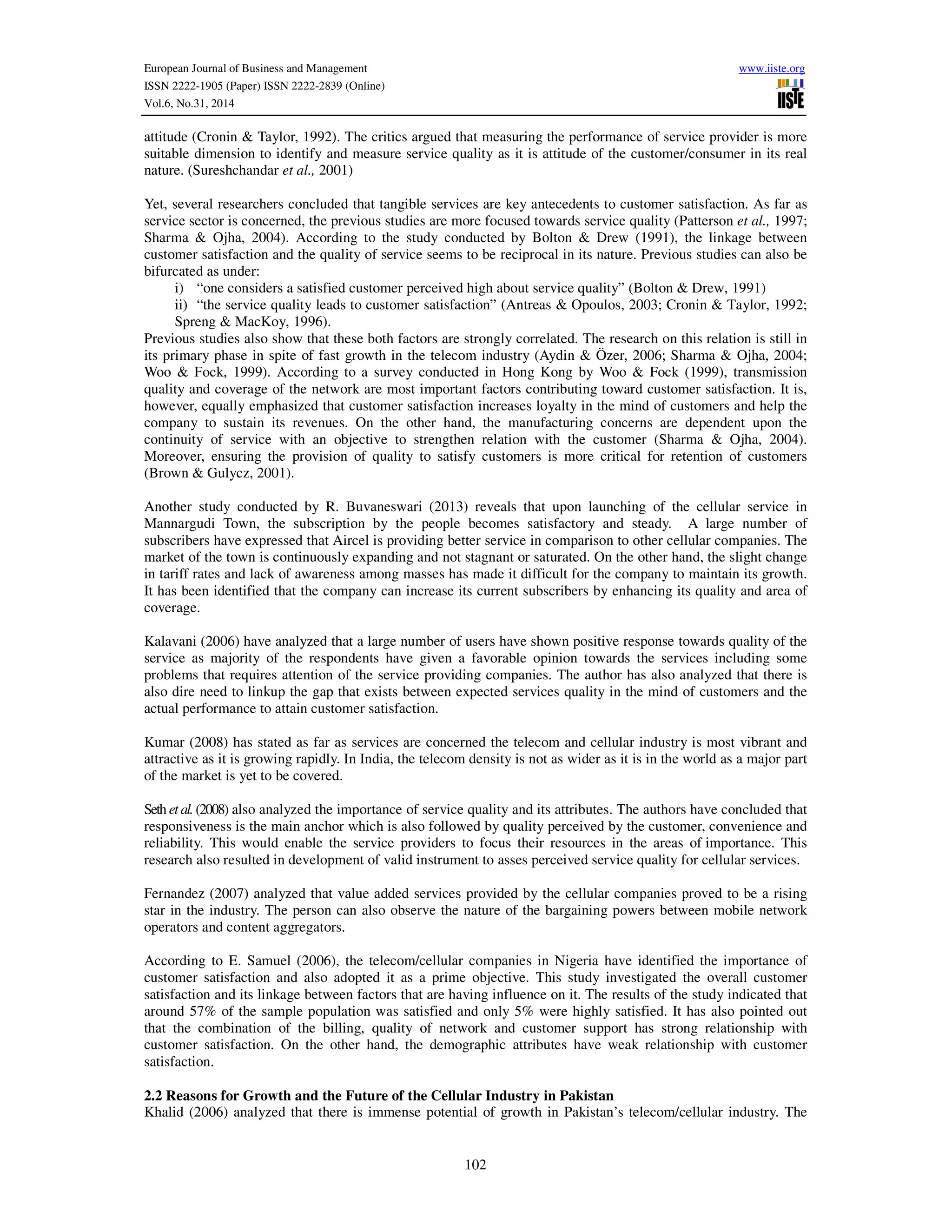
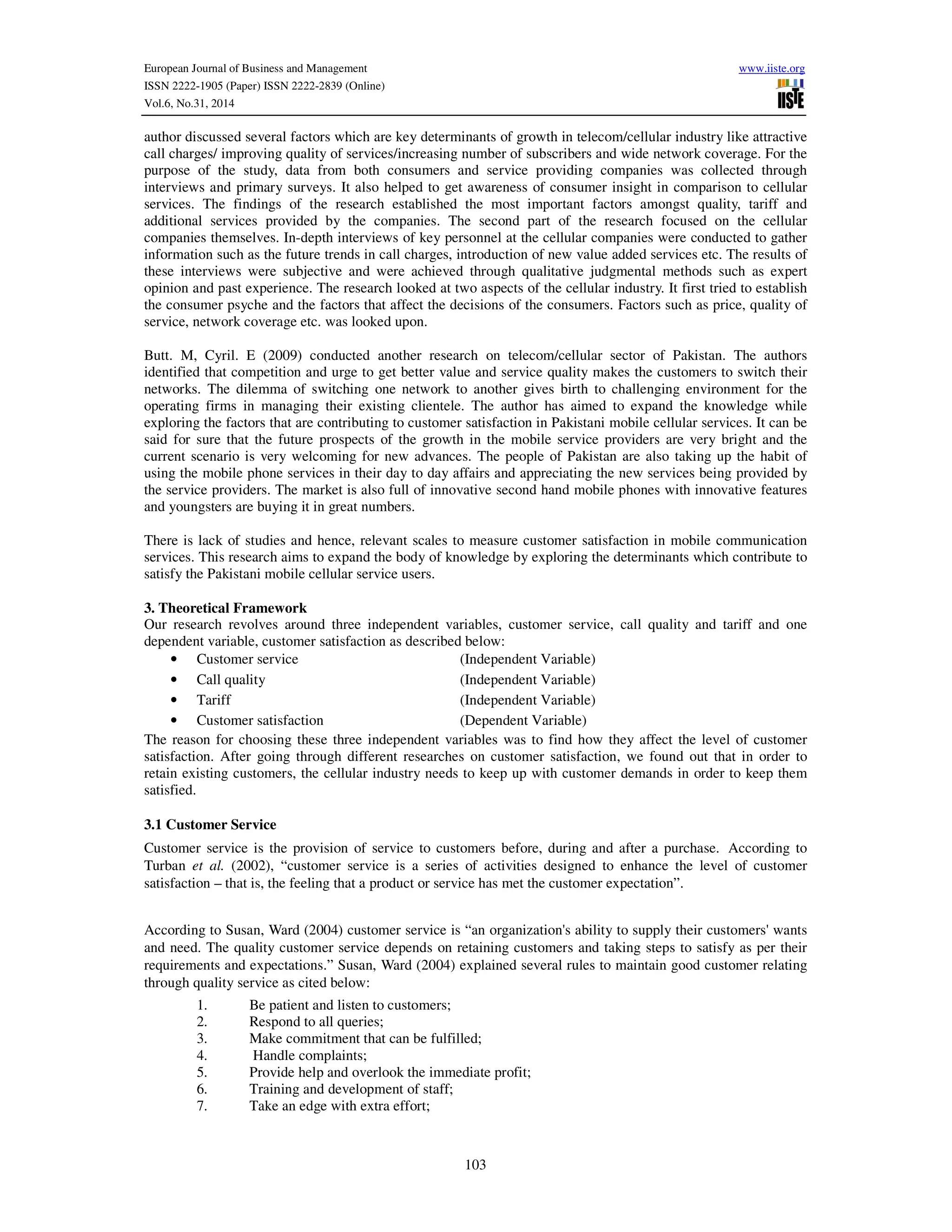
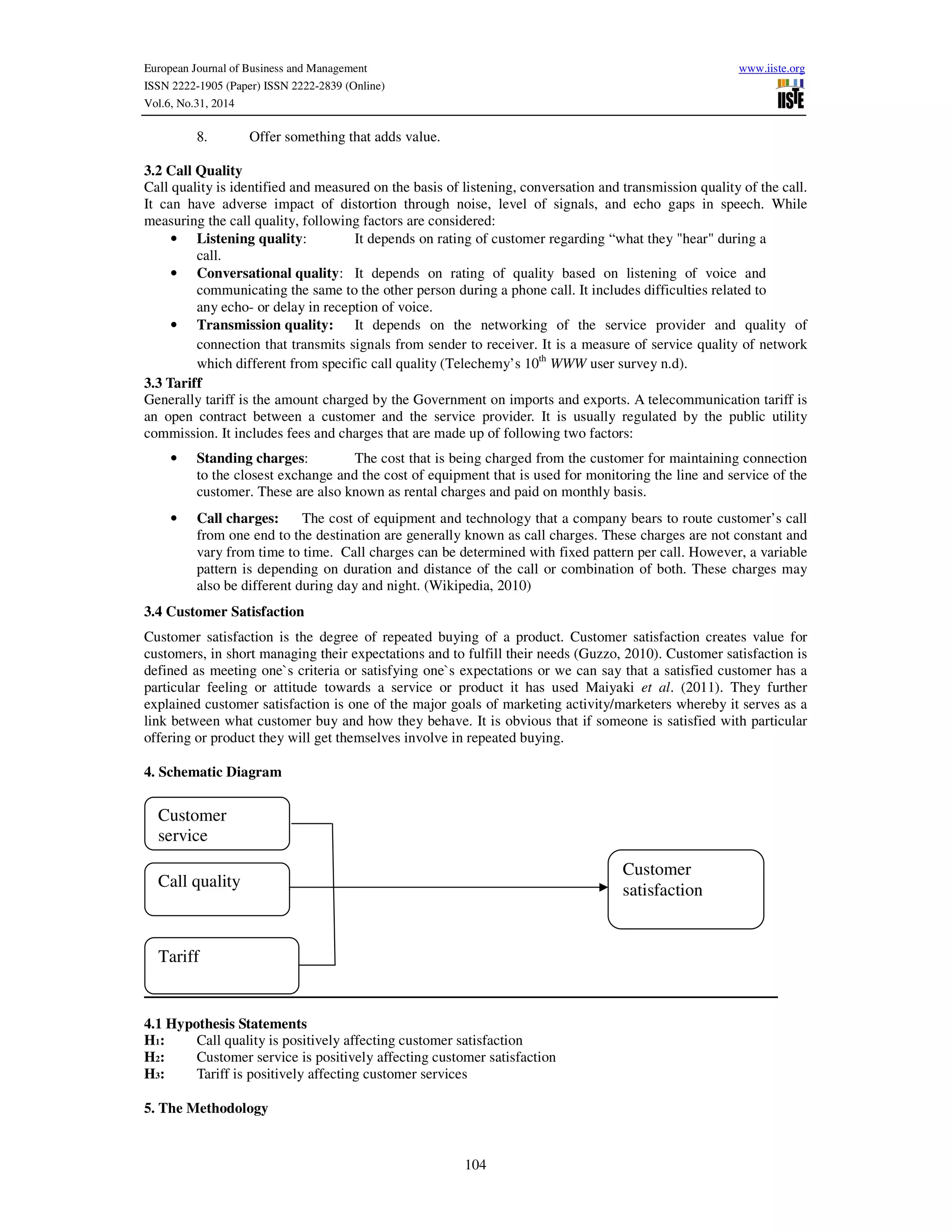
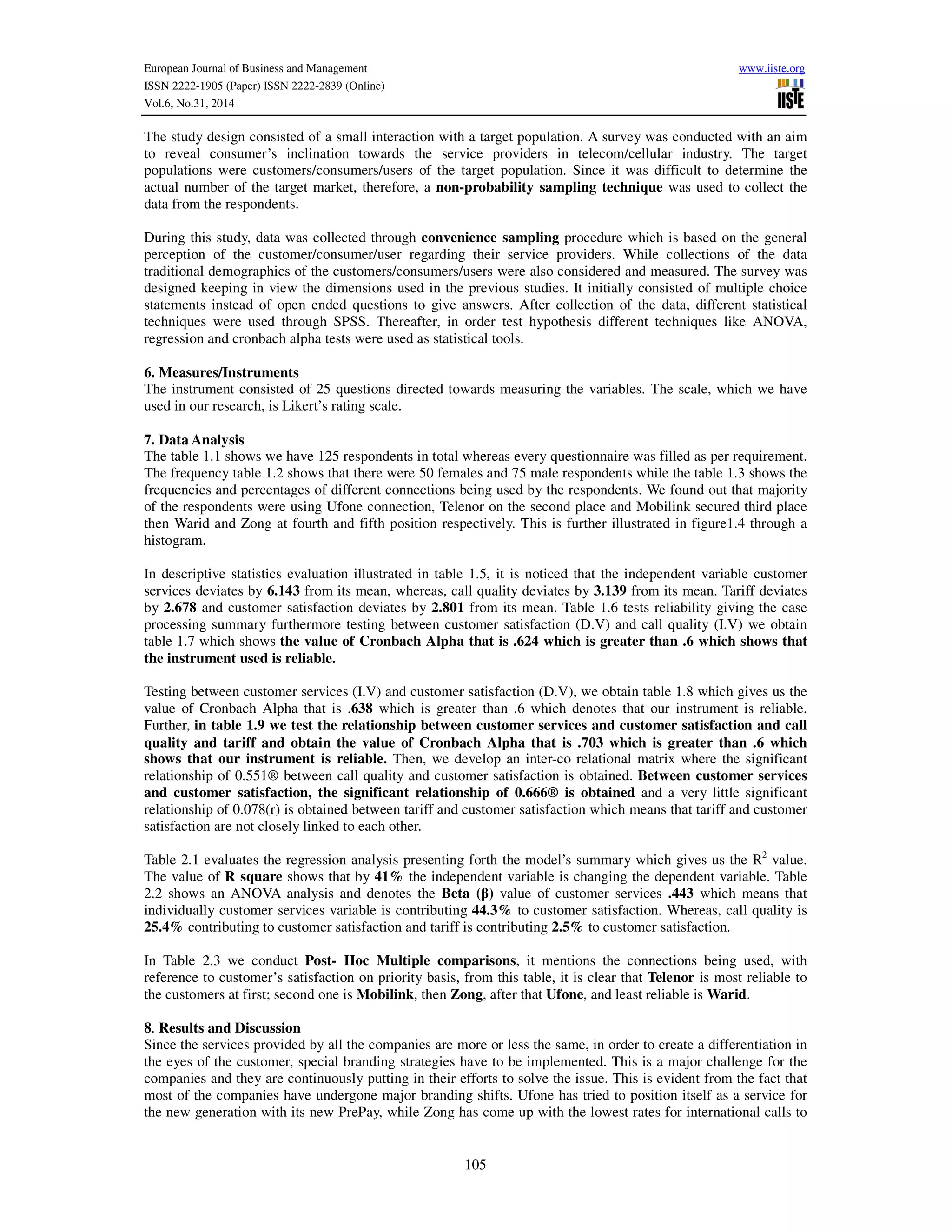
![European Journal of Business and Management www.iiste.org
ISSN 2222-1905 (Paper) ISSN 2222-2839 (Online)
Vol.6, No.31, 2014
106
position it differently. However still, branding the service in the right way has become a major challenge for the
marketers in the mobile telecommunication industry.
This research has filtered out key variables among several variables pertaining to customer satisfaction. The
findings will also be helpful for the service providers to devise new strategy in order to attain customer
satisfaction of the existing clientele. It has also identified that there is significant linkage between tariffs/ prices
and customer satisfaction. The study shows that the tariffs/prices have significant impact on the loyalty of the
customer as it ensures customer satisfaction.
It has also been analyzed that the call quality has a significant impact on customer satisfaction and it plays an
important aspect that helps the company to maintain its clientele because if primarily a customer opts a service
provider due to low tariffs but the clarity of voice in communication does not exist then eventually customer
would prefer to switch to a different network. It has also been observed that customer satisfaction is strongly
correlated with the customer services. It also verifies that better customer services lead to higher customer
satisfaction. The companies have to ensure provision of 24/7 customer services to its clients through its call
centers/ franchises and support staff. It will also ensure the increase in number of existing clientele as people
learn through experiences of other people and adapt products accordingly.
The statistical analysis has shown that Telenor is most reliable to the customers; second one is Mobilink, then
Zong, after that Ufone, and at last Warid.These results would help the service providers to design their products
keeping in view the above discussed factors. This would certainly ensure the maximisation of customer
satisfaction at the part of users and market share/profitability at the part of service providers hence creating a
win-win situation in the long run.
9. References
[1] Anderson, E. W., Fornell, C., & Lehmann, D. R. (1994). Customer satisfaction, market share, and
profitability: Findings from Sweden. Journal of Marketing, 58(July): 53-
[2] Antreas, D. A., & Opoulos, A. I. (2003). Modeling customer satisfaction in telecommunication:
Assessing the multiple transaction points on perceived overall performance of the provider. Production
and Operation Management, 12(2): 224-245.
[3] Aydin, S., & Özer, G. (2006). How switching costs affect subscriber loyalty in the Turkish mobile
phone market: An exploratory study. Journal of Targeting, Measurement and Analysis for Marketing,
14(2): 141 - 155.
[4] Bolton, R. N., & Drew, J. H. (1991). A multistage model of customers’ assessments of service quality
and value. Journal of Consumer Research, 17: 375-384.
[5] Brown, S. A., & Gulycz, M. (2001). Customer relationship management: A strategic imperative in the
world of e-business: New York: Wiley.
[6] Butt. M, Cyril. E (2009) “Modeling customer satisfaction in cellular phone services”, Journal
Kemanusiaan bil. 13, Jun 2009.
[7] Cronin, J. & Taylor, A. (1992). Measuring service quality: A re-examination and extension. Journal of
Marketing, 56(July): 55-68.
[8] E. Samuel “Customer Satisfaction in the mobile telecommunications industry in Nigeria” presented to
Blekinge Iinstitute of Technology, Department of Management, Ronneby, Sweden, in fulfilment of the
requirement for the degree of Master of Business Administration (MBA), 2006.
[9] Fernandez, Fronnie, Understanding Dynamics in an Evolving Industry: Case of Mobile VAS in India”,
2007
(http://www.emeraldinsight.com/Insight/viewContentItem.do;jsessionid=2086527F0757A565F9A6CB
AC8800F658?contentType=Article&hdAction=lnkhtml&contentId=881588&history=true>)[Viewed
4/4/09]
[10]Goode, M., & Moutinho, L. (1996). The effects of consumer age on overall satisfaction: An application
to financial services. Journal of professional service marketing, 13(2): 93-112.
[11]Guzzo, R., 2010. Customer satisfaction in the hotel industry: A case study from Sicily. Int. J. Market.
Stud., 2(2): 3-12.
[12]Islam. M (2009, November 26th
) “The analysis of customer loyalty in Bangladeshi mobile phone
operator industry” Retrieved December 28, 2010 from http://www.wbiconpro.com/501-sohel.pdf
[13]Kalwani, Banumathy, “Consumer’s Attitude towards Cell phone Services”, 2006](https://image.slidesharecdn.com/determinantsofcustomersatisfactionincellularindustryof-150205000349-conversion-gate01/75/Determinants-of-customer-satisfaction-in-cellular-industry-of-7-2048.jpg)
![European Journal of Business and Management www.iiste.org
ISSN 2222-1905 (Paper) ISSN 2222-2839 (Online)
Vol.6, No.31, 2014
107
[14]Khalid, Syed Mohammad Abdullah, Reasons for Growth and the Future of the Cellular Industry of
Pakistan (2006). Available at
SSRN: http://ssrn.com/abstract=996259 or http://dx.doi.org/10.2139/ssrn.996259
[15]Kumar, Kaliyamoorthy“Influence of Demographic Variables on Marketing Strategies in the
Competitive Scenario”, 2007
(http://www.emeraldinsight.com/Insight/viewContentItem.do;jsessionid=2086527F0757A565F9A6CB
AC8800F658?contentType=Article&hdAction=lnkhtml&contentId=881588&history=true>) [Viewed
4/4/09].
[16]Maiyaki, A.A., N.B. Noor and S.S. Mokhtar, 2011. The influence of service quality of mobile phone on
customer satisfaction in Malaysia: A students’feedback survey. J. Bus. Manag. Account., 1(1): 79-97.
[17]Oliver, R. L. (1977). Effects of expectation and disconfirmation on post exposure product evaluations.
Journal of Applied Psychology, 62(April): 246-250.
[18]Oliver, R. L. (1989). Processing of the satisfaction response in consumption: A suggested framework
and research propositions. Journal of consumer satisfaction, Dissatisfaction and complaining behavior,
2: 1-16.
[19]Parasuraman, A., Zeithaml, V. A., & Berry, L. L. (1988). Servqual: A multiple-item scale for measuring
consumer perceptions of service quality. 64(spring), 12-40.
[20]Parasuraman, A., Ziethaml, V., & Berry, L. L. (1991). Understanding customer expectations of service.
Sloan Management Review, Spring, 39-48.
[21]Patterson, P. G., Johnson, L. W., & Spreng, R. A. (1997). Modeling the determinants of customer
satisfaction for business-to-business professional services. Journal of the Academy of Marketing
Science, 25(1): 4-17.
[22]Seth et. al, “Managing the Customer Perceived Service Quality for Cellular Mobile Telephone: an
Empirical Investigation”, 2008
(http://www.emeraldinsight.com/Insight/viewContentItem.do;jsessionid=2086527F0757A565F9A6CB
AC8800F658?contentType=Book&hdAction=lnkhtml&contentId=1758667&history=true>) [Viewed
6/4/09]
[23]Sharma, N., & Ojha, S. (2004). Measuring service performance in mobile communications. The Service
Industries Journal, 24(6): 109-128.
[24]Sureshchandar, G. S., Rajendran, C., & Kamalanabhan, T. J. (2001). Customer perceptions of service
quality: A critique. Total Quality Management, 12(1): 111-124.
[25]Telechemy,s 10th WWW user survey (n,d) Retrieved December 24, 2010 from
http://www.telchemy.com/appnotes/TelchemyVoiceQualityMeasurement.pdf
[26]Turban, Efraim (2002). Electronic Commerce: A Managerial Perspective. Prentice Hall. ISBN 0-13-
185461-5.
[27]Ward. Susan (2004) “Small Business Guide” Retrieved December 20, 2010 from
http://sbinfocanada.about.com/cs/marketing/g/custserv.htm.
[28]Wikipedia: The free encyclopedia. (2010, July 30). FL: Wikimedia Foundation, Inc. Retrieved January
04, 2010 from http://en.wikipedia.org/wiki/Telecommunications_tariff
[29]Woo, S., KA, & Fock, H., K.Y. (1999). Customer satisfaction in Hong Kong mobile industry. The
Service Industries Journal, 19(3): 162-174.](https://image.slidesharecdn.com/determinantsofcustomersatisfactionincellularindustryof-150205000349-conversion-gate01/75/Determinants-of-customer-satisfaction-in-cellular-industry-of-8-2048.jpg)

